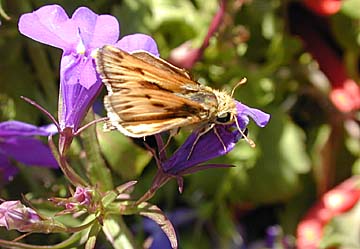Advertisement - Click to support our sponsors.


If you provide the right kind of plants,
By Stephanie Kendrick
your backyard may be the perfect venue
for a butterfly garden party, featuring
delicate, colorful fiery skippers and
passion vine butterflies
Star-BulletinWHILE the beauty of butterflies has long attracted admirers, that admiration has not always benefitted the well-dressed insect. Being pinned to a board has got to hurt.
Color photography is a more humane form of worship, allowing butterflies to be "collected" while remaining free.
But a butterfly garden is downright altruistic. The gardener collects butterflies while allowing them to remain free, giving them food and a place to reproduce.
Butterfly gardening has seen a spurt in popularity across the United States. A plethora of books, small and large, are available on the subject. Unfortunately, like most mainland gardening books, they do not address Hawaii's unique environment.

Hawaii has two indigenous butterflies and a host of imports. Many of them are tiny and easy to overlook. The indigenous Blackburn's blue, for example, has a half-inch wing span. Rev. Thomas Blackburn collected the first examples in the 1870s and sent them off to Europe, according to local entomologist Steve Montgomery. The insect is blue on top, green on bottom and is most often seen in the transition zone between the lowlands and mountains, he said.The showier of the two indigenous species is the Kamehameha butterfly. It is similar in appearance to the omnipresent monarch, but more red than orange with prominent black markings, especially under the wings. It is usually seen in higher elevations. Aiea State Park and Tantalus are good places to find them on Oahu, said Montgomery.

Horticulture consultant Gregory Koob, editor/publisher of Hawai'i Horticulture, said he'd prefer commercial butterfly breeders farm the Kamehameha rather than the monarch. "No one has asked me, but I would encourage breeders to breed Kamehameha butterflies. The caterpillars are not as voracious," he said, referring to the monarch caterpillar's ability to decimate crown flower plants.And while neither Hawaiian butterfly is endangered, Koob said butterfly gardens could boost their populations.
Besides the orange and black monarch, imported butterflies include:
Montgomery said Hawaii's imported butterfly species likely arrived as eggs in plant matter.The western pygmy blue -- Lays its eggs in pickle weed and is plentiful at West Loch Shoreline Park.
The citrus swallowtail -- Resembles bird poop in its early larval stages and as it grows develops foul-smelling orange antenna that come out if it is touched.
Two skipper butterflies, the fiery and the banana -- These are on the cusp between moths and butterflies.
The cabbage white -- A smallish white butterfly with a single or double black spot on each forewing, depending on gender.
The painted lady and painted beauty (also called the American painted lady) -- Both have orange and black markings, but unlike the monarch, are more mottled than striped.
The passion vine butterfly (or gulf fritillary) -- Again, orange and black markings appear, but the passion vine has distinctive silver spots on its underwing.
In addition to having the right plants ("Plant either crown flower or passion vines and they will come," said Montgomery), the butterfly gardener should consider lighting and blooming cycles.
"Butterfly gardens should be in full sun, preferably not too windy, but there should be good air circulation," said Koob. He also suggested staggering blooming to get butterflies year 'round.
Unlike most of the mainland, butterflies in Hawaii feed and breed all year. Though there is usually a population explosion after the rainy season makes larval food more available, said Montgomery.

Both experts agreed weed killers and fertilizers should not pose a problem in the butterfly garden. Insecticides are another issue. Koob recommended handpicking of caterpillars for gardeners who are trying to protect immature larval plants. Caterpillars can then be redistributed to larger plants, squished (ouch) or dropped in rubbing alcohol (a quick way to go). Spraying insecticides on these plants should be avoided, said Koob.While some birds do prey on butterflies (with the exception of the monarch, which is rumored to have a nasty taste), Montgomery says his bird feeder and butterfly garden seem to exist in harmony.
Montgomery takes great pleasure in his butterfly garden. "Butterflies stir the emotions of humans, especially our sense of wonder," he said. He finds their lively interaction delightful to watch.
If you'd like to try your hand at butterfly gardening, our experts have compiled a list of the plants popular with these animated works of art. The larval plants are unique to each species, but the nectar plants have broad appeal.
"They are quite specific as to where they lay their eggs, but they'll take nectar just about anywhere," said Montgomery.
Hawaii plants that feed local butterflies or their caterpillars:
NATIVE
Larval plants
A'ali'i (Dodonaea viscosa) -- Blackburn's blue
Koa (Acacia koa) -- Blackburn's blue
'Ena 'ena (Pseudognaphalium sandeiscensium) -- painted lady, painted beauty
Maiapilo, or Hawaiian caper, (Capparis sandwichiana) -- cabbage white
Mamake (Pipturus albidus) -- Kamehameha
Nectar plants
Hibiscus (Hibiscus arnottianus, H. waimea and H. kokio)
Ko'oko'olau (Bidens spp.)
Nehe (Wollastonia and Lipochaeta)
'Ohi'a lehua (Metrosideros polymorpha)
NON-NATIVE
Larval plants
Butterfly weed (Asclepias curassivica) -- monarch
Cabbages, broccoli (Brassica spp.) -- cabbage white
Crown flower (Calotropis gigantea) -- monarch
Passionflower vines (Passiflora spp.) -- passion vine butterfly
Thistles (Cirsium spp.) -- painted lady
Citrus trees (Citrus ssp.) -- citrus swallowtail
Nectar plants
Aster (Aster spp.)
Bougainvillea (Bougainvillea glabra)
Cosmos (Cosmos bipinnatus and C. sulphureus)
Hibiscus (Hibiscus rosa-sinensis)
Impatiens (Impatiens wallerana)
Ixora, also Popo lehua (Ixora spp.)
Lantana (Lantana camara)
Marigold (Tagetes spp.)
Butterfly bushes (Buddleia davidii, B. madagascariensis and B. asiatica)
Verbena (Verbena spp.)
Zinnia (Zinnia elegans)
The 46th Annual Kunia Orchid show runs today, tomorrow and Sunday. The event takes place from 9 a.m. to 5 p.m. today and tomorrow and 9 a.m. to 4 p.m. Sunday at the Kunia gymnasium off of Kunia Road. Cost: $2 donation. Correction
Incorrect dates were given in last week's column.
Click for online
calendars and events.